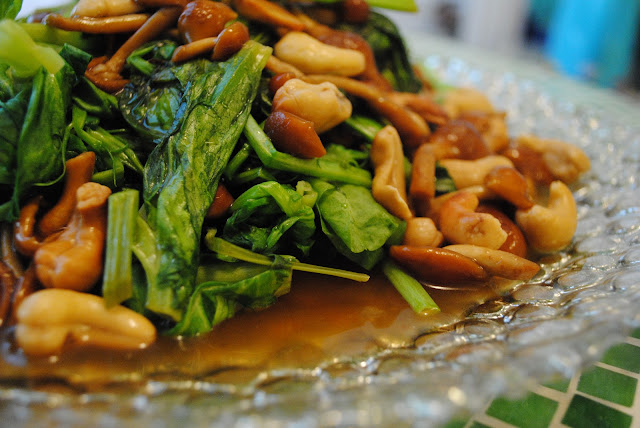I'm a believer in the power of greens: so delicious, so good for you and so much variety it's impossible to get tired of eating them. While most people become bored with wintertime produce,
I actually love this time of year at the farmers market because the stalls are full of leafy greens, chards, citrus and root vegetables.
I was excited to come across pea greens at the farmers market a couple of weeks ago, and have been playing around with ways to cook them ever since. These greens are crunchy and taste of freshly shelled peas, so they would work beautifully in their raw state in a salad. I've also seen these greens at Safeway, called dow miu. Now is the best time to purchase them as they are in season, as farmers gear up for fresh spring peas.
I absolutely love the tangy-sour flavor of Ponzu, so I decided to combine them with buttery toasted cashews and earthy mushrooms to create this light and refreshing dish.
Ingredients:
- A handful of sea-salted cashews
- 2 Tablespoons olive oil
- 4-6 ounces mushrooms, such as Nameko or Shitake
- I large bunch of pea greens
- 1/4-1/2 cup ponzu
- 1/4 cup water
1. Trim the ends of the pea greens stems
2. Heat a large pot over medium heat and add the cashews. Toast them dry while stirring until they are golden and fragrant.
 |
| gorgeous tendrils |
3. Next turn down the heat, add the olive oil and immediately add the mushrooms, stirring vigorously so the nuts do not burn. The oil really kicks up the cooking process.
4. Add the ponzu and bring to a simmer - coating the mushrooms and cashews in the sauce.
5. Add the entire bunch of pea greens and the water. Stir the greens so that they are coated - about one minute. Cover and allow the greens to steam for 1-2 minutes.
6. To finish, plate and garnish with a sprinkling of kosher or sea salt. Serve immediately.
Buon Appetito, Tutti!





































